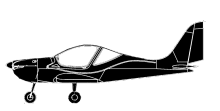
ASN Wikibase Occurrence # 43672
This information is added by users of ASN. Neither ASN nor the Flight Safety Foundation are responsible for the completeness or correctness of this information.
If you feel this information is incomplete or incorrect, you can submit corrected information.
| Date: | Saturday 15 September 2007 |
| Time: | 13:43 |
| Type: |  Evektor SportStar |
| Owner/operator: | SkyRaider Aviation, Inc |
| Registration: | N616EV |
| MSN: | 20060709 |
| Total airframe hrs: | 607 hours |
| Engine model: | Rotax 912ULS |
| Fatalities: | Fatalities: 2 / Occupants: 2 |
| Aircraft damage: | Substantial |
| Category: | Accident |
| Location: | Erie, CO -
 United States of America United States of America
|
| Phase: | Manoeuvring (airshow, firefighting, ag.ops.) |
| Nature: | Training |
| Departure airport: | Erie, CO (EIK) |
| Erie, CO (EIK) | |
| Investigating agency: | NTSB |
| Confidence Rating: |
The accident flight was the student pilot's first instructional flight towards a Light Sport Pilot certificate. He was receiving instruction from a commercial pilot with a flight instructor certificate (CFI). According to multiple witnesses, the airplane entered a spin while turning from the upwind leg to the crosswind leg following a touch-and-go landing. The airplane impacted terrain in a left wing down, nose low attitude. Postaccident examination of the airplane and its systems revealed no mechanical anomalies. The investigation disclosed that the airplane was over the certified gross weight at the time of departure for the accident flight. A review of the Aircraft Operating Instructions provided by the manufacturer, revealed insufficient data to accurately calculate the effects of density altitude on the performance of the airplane for takeoff and landing. The manual also lacked sufficient data to calculate the fuel burn of the airplane for any altitude higher than an international standard altitude of 2,000 feet. This additional information is not specified as a requirement by the current ASTM consensus standards. Density altitude at the time of the accident was calculated to be 7,800 feet. As no mechanical reason was discovered for the loss of control, it is likely the CFI allowed the airspeed to decay until an inadvertent stall occurred, and he was unable to recover prior to impact.
Probable Cause: The flight instructor's failure to maintain sufficient airspeed during takeoff-initial climb to avoid a stall/spin. Contributing to the accident was the flight instructor's inadequate preflight planning, his failure to calculate the airplane's weight and balance, the high density altitude, inadequate information for preflight planning provided by the manufacturer, and the insufficient standards for Pilot Operating Handbook information required by the ASTM consensus standards.
Accident investigation:
 |
|
Sources:
NTSB: https://www.ntsb.gov/_layouts/ntsb.aviation/brief.aspx?ev_id=20070918X01410&key=1
Location
Revision history:
| Date/time | Contributor | Updates |
|---|---|---|
| 28-Oct-2008 00:45 | ASN archive | Added |
| 13-Apr-2010 12:12 | TB | Updated [Aircraft type, Other fatalities, Plane category, ] |
| 21-Dec-2016 19:24 | ASN Update Bot | Updated [Time, Damage, Category, Investigating agency] |
| 04-Dec-2017 18:52 | ASN Update Bot | Updated [Other fatalities, Source, Narrative, Plane category] |
Corrections or additions? ... Edit this accident description
The Aviation Safety Network is an exclusive service provided by:


 ©2024 Flight Safety Foundation
©2024 Flight Safety Foundation